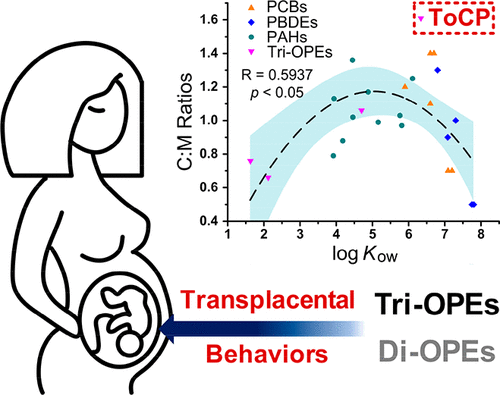当前位置:
X-MOL 学术
›
Environ. Sci. Technol.
›
论文详情
Our official English website, www.x-mol.net, welcomes your feedback! (Note: you will need to create a separate account there.)
Transplacental Behaviors of Organophosphate Tri- and Diesters Based on Paired Human Maternal and Cord Whole Blood: Efficiencies and Impact Factors
Environmental Science & Technology ( IF 11.4 ) Pub Date : 2021-01-04 , DOI: 10.1021/acs.est.0c06095 Xiaolei Wang 1, 2 , Pengyu Chen 1 , Lixia Zhao 3 , Lingyan Zhu 1 , Fengchang Wu 2
Environmental Science & Technology ( IF 11.4 ) Pub Date : 2021-01-04 , DOI: 10.1021/acs.est.0c06095 Xiaolei Wang 1, 2 , Pengyu Chen 1 , Lixia Zhao 3 , Lingyan Zhu 1 , Fengchang Wu 2
Affiliation

|
Organophosphate tri- and diesters (tri-OPEs and di-OPEs) were quantified in 63 paired maternal and cord whole blood samples collected in Hubei, China, in which tri-o-cresyl phosphate (ToCP) was predominant. The transplacental transfer efficiencies (expressed as cord blood to maternal blood (C:M) concentration ratios) of aryl-tri-OPEs, such as ToCP (1.61) and triphenyl phosphate (TPHP) (1.06), were higher than those of alkyl-tri-OPEs (0.66–0.76). For the target tri-OPEs and some traditional organic compounds, the C:M ratios first increased with log Kow in the range of 1.63–5.23 and then decreased, showing a parabolic relationship. However, ToCP, with a log Kow of 6.34, deviated from this relationship and displayed the highest C:M ratio (1.61). Molecular docking indicated a very strong binding affinity between ToCP and transthyretin, suggesting that ToCP might be actively transported by transthyretin in the placenta. The di-OPE levels in the blood samples were significantly lower than the corresponding tri-OPE levels, and those in the cord blood were influenced not only by their transplacental behaviors but also by their low excretion rates and the metabolic characteristics of their parent compounds in the fetus. This study provides useful information for accurately assessing the health risks posed by tri-OPEs to pregnant women and fetuses.
更新日期:2021-03-02



























 京公网安备 11010802027423号
京公网安备 11010802027423号